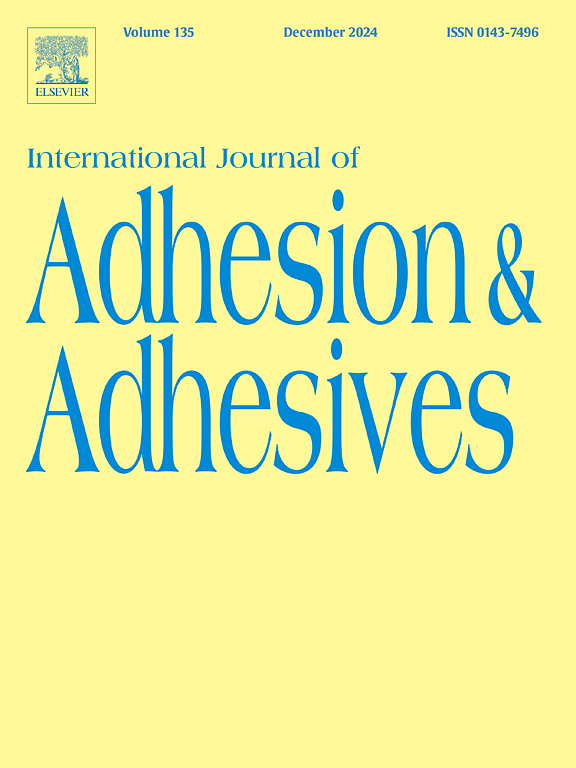Innovative magnetic treatment improves the dentin bonding performance of etch-and-rinse adhesives
IF 3.5
3区 材料科学
Q2 ENGINEERING, CHEMICAL
International Journal of Adhesion and Adhesives
Pub Date : 2025-01-30
DOI:10.1016/j.ijadhadh.2025.103950
引用次数: 0
Abstract
Objective
To evaluate the effect of etch-and-rinse two-step adhesives doped with magnetic Fe₃O₄ nanoparticles (NP), associated with an external magnet, on dentin bonding.
Material and methods
Teeth were restored using Adper Single Bond 2 (SB) or OptiBond S (OB) according to the following groups (n = 5): SB and OB controls; SB-FeMag and OB-FeMag (NP + external magnet); SB-Fe and OB-Fe (NP without an external magnet). NP were incorporated at 2 % concentration. The external magnet was positioned below (apical) the tooth for 30 s before curing the adhesives. Resin-dentin sticks were tested for microtensile bond strength (μTBS) and nanoleakage at 24 h and after bacterial collagenase challenge. Failure modes were categorized by stereomicroscope. Data were statistically analyzed using two-way ANOVA and Tukey's test (p < 0.05).
Results
OB-Fe exhibited statistically higher 24 h μTBS values compared to SB-FeMag and SB-Control. After collagenase challenge, OB-Fe and SB-FeMag achieved the highest μTBS values, significantly different from SB-Fe and SB-Control. OB-Fe, OB-FeMag and SB-FeMag maintained their bond strength (p > 0.05). SB-Fe and control groups showed a significant μTBS reduction after challenge, with adhesive failures predominating in the controls. All groups exhibited silver infiltration in the hybrid layer. However, SB-control revealed a gap after collagenase challenge, while OB-FeMag reduced these silver deposits.
Conclusions
The incorporation of Fe3O4 nanoparticles into etch-and-rinse adhesives represents an innovative magnetic treatment that maintains stable bonding to dentin.
创新的磁性处理提高了蚀刻和冲洗粘合剂的牙本质粘合性能
目的探讨Fe₃O₄磁性纳米颗粒(NP)掺杂与外磁铁结合的刻蚀-漂洗两步胶粘剂对牙本质结合的影响。材料和方法采用Adper Single Bond 2 (SB)或OptiBond S (OB)修复牙齿,分为以下组(n = 5): SB和OB对照组;SB-FeMag和OB-FeMag (NP +外磁铁);SB-Fe和OB-Fe(不带外部磁铁的NP)。NP以2%的浓度掺入。在固化粘接剂之前,将外磁铁放置在牙齿下方(根尖)30秒。测定树脂-牙本质棒在24 h和细菌胶原酶刺激后的微拉伸结合强度(μTBS)和纳米渗漏率。用体视显微镜对失效模式进行分类。数据采用双因素方差分析和Tukey检验(p <;0.05)。结果sb - fe的24 h μTBS值高于SB-FeMag和SB-Control。胶原酶攻毒后,OB-Fe和SB-FeMag的μTBS值最高,与SB-Fe和SB-Control差异显著。OB-Fe、OB-FeMag和SB-FeMag的结合强度保持不变(p >;0.05)。SB-Fe组和对照组攻毒后μTBS显著降低,以粘附失败为主。所有组均表现出银在杂化层的浸润。然而,SB-control在胶原酶刺激后显示出空白,而OB-FeMag则减少了这些银沉积。结论将Fe3O4纳米颗粒掺入蚀刻冲洗胶粘剂中是一种创新的磁性处理方法,可以保持与牙本质的稳定结合。
本文章由计算机程序翻译,如有差异,请以英文原文为准。
求助全文
约1分钟内获得全文
求助全文
来源期刊

International Journal of Adhesion and Adhesives
工程技术-材料科学:综合
CiteScore
6.90
自引率
8.80%
发文量
200
审稿时长
8.3 months
期刊介绍:
The International Journal of Adhesion and Adhesives draws together the many aspects of the science and technology of adhesive materials, from fundamental research and development work to industrial applications. Subject areas covered include: interfacial interactions, surface chemistry, methods of testing, accumulation of test data on physical and mechanical properties, environmental effects, new adhesive materials, sealants, design of bonded joints, and manufacturing technology.
 求助内容:
求助内容: 应助结果提醒方式:
应助结果提醒方式:


